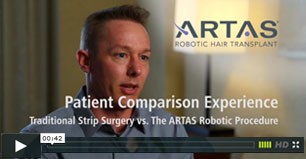How Does Female Pattern Hair Loss Differ from Male Pattern Hair Loss?
Written by Dr. Griffin
How is hair loss in women different from men? Our Philadelphia-area Griffin Hair Restoration Center team explains that knowing how these two forms of hair loss compare can help you treat your own thinning hair more effectively. As many as half of all men and women will experience hair loss due to androgenetic alopecia (the medical term for male and female pattern baldness) during their lifetime.
Pattern hair loss is a condition characterized by progressive thinning of the hair in a specific and predictable way. While male pattern baldness is widely recognized, many people are unaware that women can also experience specific hair loss patterns. Some of the primary differences include the age when thinning starts, parts of the scalp that first develop signs of thinning, and health conditions that are linked to hair loss for men and women.
Pattern Hair Loss Usually Has an Earlier Onset in Men
The risk of hair loss increases with age for both men and women. Most men will experience some type of hair loss by their 30s, while women tend to begin to experience it 10 to 15 years later—and usually after menopause.
The Pattern of Hair Loss Is Different
Another thing to note is that hair loss presents differently in men and women. Female pattern hair loss will often look different from typical “baldness.” Men will usually get a receding hairline and bald spot, while women see hair loss presenting as a widening of the central part and subtle thinning all over. Women tend to retain their frontal hairline, aside from some normal recession as they age, with thinning often starting at the part line, then developing generally all over the head. It’s unlikely for near or total baldness to occur for women.
Treatment Options Aren’t Exactly the Same
Minoxidil is a highly recommended treatment for both men and women who are experiencing hair loss. Men commonly use topical minoxidil that’s five percent strength, while women have the option of two percent or five percent products. GHR has its own topical formula for women, which contains multiple hair growth-enhancing ingredients. Oral medication like spironolactone and oral minoxidil may be prescribed. If other medical treatments aren’t effective, we may recommend a hair transplant. Platelet-rich plasma therapy is a non-surgical treatment that also may be beneficial.
Contact our team at the Philadelphia area’s Griffin Hair Restoration Center for more details. Call us at (215) 561-9100 or submit a contact form.

